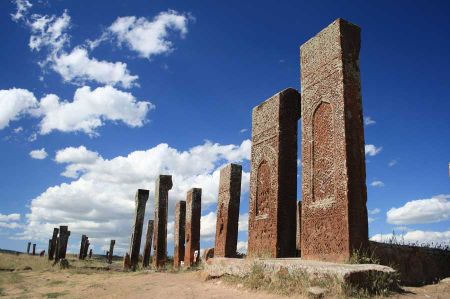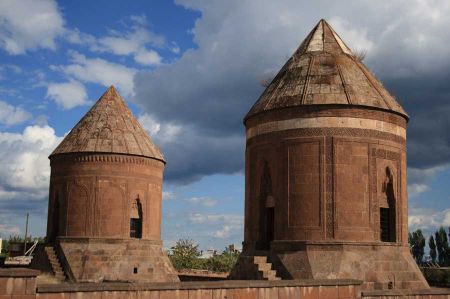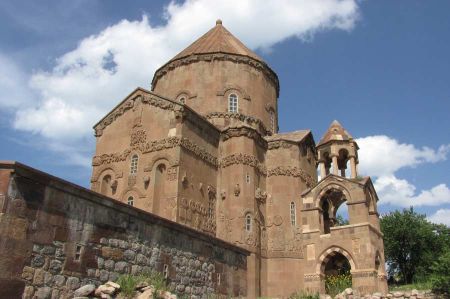Trip to Van Lake and the surrounding area
- Written by Portal Editor
We, that are 20 members of the HÜR-TÜRK-Verein Alanya (Free Turkish-German Friendship Association) and another 4 guests, had the common wish to travel to Van Lake.
The first day of travel began with the flight from Antalya via Ankara to Van, where the tour guide Halim, who had flown in from Istanbul, was waiting for us and welcomed us in perfect German. He and our bus driver Ibo were our companions for the following 5 days.
After a city tour we climbed the castle of Van. It is the most important and most magnificent guarantor of the Urartian culture, which started about 3000 years ago.
The city was destroyed during the First World War and later rebuilt 5 km away.
Van Lake is the largest lake in Turkey, it is 180 km long and 120 km wide, about seven times the size of Lake Constance. It is about 1700 meters above sea level and contains a lot of soda. Its salinity is around 13 percent. It originated from a trench. The volcano Nemrut spilled the outflow of the lake when it erupted. The water level is regulated solely by evaporation. It fluctuates by up to 4 meters. Already close the shore it reaches a depth of 250 meters. Due to the high salinity, only carp-like fish can live in the lake.
Hotels with lake view at Van Lake
 In the evening we moved into our rooms in the Merit –Şahmaran - Hotel, which is located directly on the lake shore. All guests had a lake view. But we were very hungry and nothing could stop us from the buffet.
In the evening we moved into our rooms in the Merit –Şahmaran - Hotel, which is located directly on the lake shore. All guests had a lake view. But we were very hungry and nothing could stop us from the buffet.
On the second day, after breakfast, we went east by bus. In the night a little storm raged with lot of rain, now we had brilliant sunshine. After a short bus ride we visited the old castle ruins of Çavuştepe, where we also met the castle guide Mehmet. He explained "his" castle to us in all details. He was one of the few able to read and write the ancient Urartian cuneiform script, which was carved into the rock. He also had ancient grain in his pocket. It was petrified over the millennia.
Then we drove further east to Hoşap-Güzelsu, where we wanted to see a second fortress, the church of which was renovated. It was forbidden to enter, but the director was to much proud of getting some Yabancı visitors and asked us to come in after all. Later he waved for good bye and was happy about our donation. In the village we were eyed by every child, they always wanted to know where such blonde people came from.
On the way back we visited a famous kilim weaving mill that has been family-owned for generations. Kilim - Manufacturing is one of the most important handicraft products in Van. Unfortunately, the prices were disproportionately high, so that the hoped-for business came off only sparsely.
In the immediate vicinity there was an enclosure in which the so-called Van cats were located. It is fascinating when the cat looks at you from an amber and a blue eye. They are strictly protected as local species.
But now some women wanted to get to know the ancient Armenian art of silversmithing. First we went to a workshop, but then very quickly to the sales room. Many struck, to the dismay of their husbands, who had to take out their wallets.
Tour to Agdamar Island in Van Lake
 The third day brings us to Akdamar Island in Lake Van by bus. We reach the island in 20 minutes by boat. Here you can admire an old Armenian church (Church of the Holy Cross) from the 9th century. It has not yet been agreed whether the Armenians can reopen their church or whether the Turkish state turns it into a museum.
The third day brings us to Akdamar Island in Lake Van by bus. We reach the island in 20 minutes by boat. Here you can admire an old Armenian church (Church of the Holy Cross) from the 9th century. It has not yet been agreed whether the Armenians can reopen their church or whether the Turkish state turns it into a museum.
Another short tour of the island, whose variety of flowers overwhelmed everyone, bought some souvenirs, and then the boat brought us back to the mainland.
The journey continues westwards via Tatvan to the crater lakes on Mount Nemrut. Here we had to change to 2 minibuses because the streets are narrow, bad and dusty. There are 2 lakes in the crater, a large blue cold and a small green, warm lake that receives its heat from the interior of the earth. The most beautiful flowers and grasses can be seen everywhere. We enjoy this sight.
Then we get back on our bus and visit the old Selçuk tombs in Ahlat. In this old cemetery there are about 1000 gravestones, which are from between the 12th and 16th centuries. Today we saw and experienced a lot, now we go back to the hotel and our beloved buffet.
On the fourth day, the bus now heads northeast, finally towards Ararat. We are very excited to see whether it will show up in full size today without any clouds covering the peaks?
Mount Ararat is an old volcano. It consists of two peaks. The height of the great Ararat is 5.165m, it is the highest mountain in Turkey. The small Ararat has a conical shape and is 3.925m high. Both were created by volcanic explosions. The peaks covered with snow are a sensation in Eastern Anatolia. The legendary mountain is said to be the place where Noah put his ark on land. However, clear evidence is still missing.
We are approaching the gigantic five-thousand-meter peaks that appear majestically before us. It presents itself in full size, bombastic and cloud-free, so lucky.
We continue east to the Turkish-Iranian border. We quickly take a photo behind the bars of the larger-than-life huge Ayatholla Kohmeni. Somehow the mood here is oppressive.
On the way back, bus driver Ibo takes us to a nice, very quaint restaurant in the small town of Doğubayazıt. It looks like a grotto here. The replica of Noah's ark could also be seen here. After this special stop we went back to Van.
On the way in Muradiye there was still a beautiful waterfall to admire, which could only be reached via a rocking suspension bridge. Students from Bitlis University asked us to dance with them, wanted to take photos with us. It was a very interesting, surprising meeting for us.
Then it was time to go back.
On the last day during breakfast right on the lake, some clouds came up. A very nice time came to an end for us. We had to pack our bags because we went back to Alanya today. Since there was still some time, we drove into the city again. Some of us wanted to visit the Van Museum, others wanted to buy kilims or silver jewellery quickly.
We dropped off our guide Halim at the airport and wished him a good flight back to Istanbul. We later flew back to Alanya via Ankara.
The bottom line is that security concerns in this politically troubled province, which may have existed only a few years ago, quickly dissipated.
In terms of infrastructure, we found an amazingly developed area with well-developed roads, modern cities with high schools and universities, but above all with a sociable and very friendly population that is 80 percent Kurdish. We always felt that we as Yabancı are welcome guests here.
The travel time was also chosen correctly. Spring with its blooming meadows and lush green made the already grandiose landscape with the huge Van Lake and the still snow - covered mountains in the background seem even more magnificent.
Since the travel group was right in size and composition, one can look at it as a successful travel talk. The program and tour guide, but also the bus and driver were perfect.
Karin Jurthe
Please read as well:
Györ - The Archaeological Significance of Arrabona
Cycle path exploration Lednice - with AZUB Trike and BTurtle
